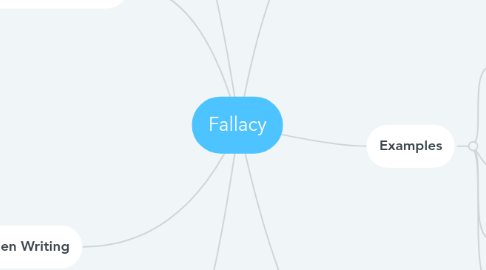
1. Importance
1.1. Fallacies are important because logic is important.
2. Tips to Avoid Fallacy
2.1. 1. Never try to deceive anyone
2.2. 2. try your best
2.3. 3. Be skeptical!
2.4. 4. Diagram or outline the steps in your argument. Then examine the gaps between the steps.
2.5. 5. doing your own research into the logical fallacies and trying to recognize them in your own writing.
3. Fallacy to Avoid When Writing
3.1. Component of Fallacies
3.1.1. Component fallacies are errors in inductive and deductive reasoning or in syllogistic terms that fail to overlap.
3.2. Fallacies of Relevance
3.2.1. These fallacies appeal to evidence or examples irrelevant to the argument at hand.
3.3. Fallacies of Ambigiuty
3.3.1. These errors occur with ambiguous words or phrases, the meanings of which shift and change in the course of discussion. Such more or less subtle changes can render arguments fallacious.
3.4. Fallacies of Omission
3.4.1. These errors occur because the logician leaves out material in an argument or focuses exclusively on missing information.
4. Related Terms
4.1. Falsehood
4.1.1. The state of being untrue
4.2. Syllogism
4.2.1. A form of deductive reasoning where you arrive at a specific conclusion by examining two other premises or ideas.
5. Definition
5.1. A fallacy is an illogical conclusion, but not necessarily a false statement.
6. Examples
6.1. a. Appeal to Popular Opinion
6.1.1. Using the popularity of a premise or proposition as evidence for its truthfulness. This is a fallacy which is very difficult to spot because our “common sense” tells us that if something is popular, it must be good/true/valid, but this is not so, especially in a society where clever marketing, social and political weight, and money can buy popularity.
6.2. b. Ad Hominem Attack
6.2.1. This is when you attack your opponent as a human being rather than dealing with their arguments. For example: “Einstein here says space-time is a continuum, but he’s a creepy little weirdo with awful hair, so he must be wrong!”
6.3. c. False Dichotomy
6.3.1. A situation in which two alternative points of view are presented as the only options, when others are available
6.4. d. Non Sequitur
6.4.1. This is when you draw a conclusion that doesn’t follow logically from the evidence.
